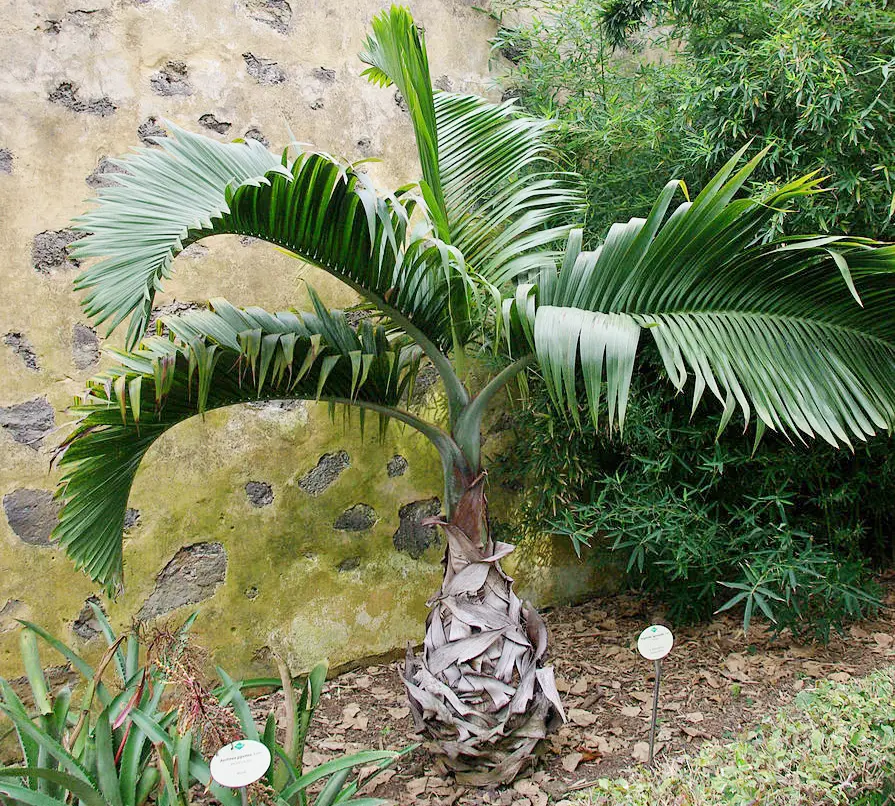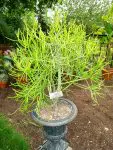This post contains affiliate links. If you buy something from one of our links we may earn a commission. Thanks

Queen palms are not only a staple in tropical landscapes, but they can also add a touch of the exotic to indoor spaces.
Queen Palm indoor care requires a bright, indirect light source, consistent watering to keep the soil moist but not waterlogged, and a well-draining soil mixture.
Fertilizing every 4-6 weeks during the growing season with a balanced fertilizer supports its growth.
Temperature-wise, they prefer a range of 60-85°F, and higher humidity levels. Pruning of yellow or brown fronds helps maintain its appearance and health.
These stunning plants, also known as Syagrus romanzoffiana, have long, feathery fronds that sway gracefully in the breeze, making them favorite indoor palms among indoor plant enthusiasts.
But before you bring a queen palm indoors, it’s important to understand Queen Palm indoor care requirements to ensure its longevity and beauty.
In this post, we’ll explore everything you need to know about queen palm indoors, including its origin, growth requirements, and how to care for it in the best way possible.
So, whether you’re a seasoned indoor gardener or a beginner, this guide is the perfect starting point to bring a touch of a tropical paradise into your home.
Queen Palm Quick Facts
| Mature Height: | 20-50 ft |
| Mature Width: | 5-10 ft |
| Sunlight: | Full Sun |
| Growth Rate: | Fast |
| Botanical Name: | Syagrus romanzoffiana |
| Grows Well In Zones: | 4-11 patio / 9-11 outdoors |
Buy your Queen Palm seeds here on Amazon
What Is A Queen Palm (Syagrus romanzoffiana)?
The Queen Palm, also known as Syagrus romanzoffiana, is a tall, elegant palm tree native to South America.
It is known for its feathery fronds and smooth, slender trunk that can grow up to 50 feet tall in the right conditions.
Despite its tropical origins, Queen Palm can be successfully grown indoors with the proper care.
Benefits of Having a Queen Palm Indoors
Not only does Queen Palm add a touch of tropical elegance to any room, but it also has several benefits for indoor air quality.
The plant’s large fronds are great for purifying the air by removing harmful pollutants, and it also increases humidity levels, helping to reduce dryness in the air.
What You Will Learn
This post will provide a comprehensive guide on how to care for the Queen Palm indoors.
We will cover everything from choosing the right plant to proper lighting, watering, fertilization, and maintenance, as well as potential problems and solutions.
Whether you’re a seasoned indoor gardener or just starting out, this post will give you all the information you need to grow a healthy, beautiful Queen Palm indoors.
Understanding Queen Palm Indoor Care
The Queen Palm is a majestic plant that is both beautiful and easy to care for but to grow a healthy plant, it’s important to understand its natural habitat and growth requirements.
In this section, we’ll delve into the origin of the Queen Palm, its physical characteristics, and what it needs to thrive indoors. By gaining a deeper understanding of this palm tree, you’ll be able to provide the best care possible, ensuring its health and longevity. Whether you’re a seasoned indoor gardener or just starting out, this section will give you a comprehensive overview of everything you need to know about this palm.
Origin and Natural Habitat
The Queen Palm is native to South America, specifically Brazil, Argentina, and Uruguay.
In its natural habitat, it can be found growing in warm, tropical climates, often near water sources.
The plant is known for its ability to adapt to different growing conditions, making it a popular choice for indoor gardening.
Physical Characteristics
This palm is a tall, slender tree with a smooth, gray trunk that can reach up to 50 feet in height.
Its most striking feature is its large, feathery fronds that grow in a symmetrical crown at the top of the trunk.
The fronds are green and have a glossy appearance, adding to the plant’s overall tropical aesthetic.
Growth Requirements
Queen Palm is a fast-growing plant that likes full sun and indoors requires bright, indirect light at a minimum to thrive.
It prefers temperatures between 60-85°F and high humidity levels. The plant also requires well-draining soil and consistent watering to maintain its health.
It is important to note that the Queen Palm does not tolerate drought, and its fronds can suffer damage if the soil is allowed to dry out completely.
Regular fertilization is also important for optimal growth, as the plant requires a consistent supply of nutrients to maintain its lush foliage.

1. Choosing a Queen Palm for Your Home
With its tall, elegant appearance and air-purifying capabilities, the Queen Palm makes a great addition to any indoor space. But with so many palm trees available, it can be difficult to choose the right plant for your home.
In this section, we’ll go over the key considerations to keep in mind when selecting a Queen Palm, including size, light requirements, watering and humidity needs, and soil type.
By following these guidelines, you can choose a healthy, thriving plant that will bring beauty and life to your home for years to come.
Size Considerations
When choosing a Queen Palm, it’s important to consider the size of the plant and the size of your indoor space.
Queen Palms can grow up to 50 feet tall outdoors, but they won’t reach that size indoors.
But high ceilings are a good idea. Smaller palm plants are also available for growing indoors.
If you have limited space, consider selecting a smaller variety or a young plant that can be trained to grow in a compact form for indoor use.
Keep in mind that any plant will continue to grow over time, so make sure you have enough space to accommodate its mature size.
2. Can You Keep A Queen Palm Small?
You can’t make most palm trees shorter, but you can slow an indoor palm plant’s growth by creating conditions that crowd its roots. Instead of transplanting your palm into a larger container as it grows, leave it in the smaller container. If the roots don’t have room to grow, the palm’s growth will slow. https://homeguides.sfgate.com/indoors-outdoors-palm-tall-94676.html
Small Palm Varieties
If you can’t handle a large palm here are some smaller more manageable indoor palm tree varieties to try.
The Kentia Palm is a very slow-growing plant that typically reaches an ultimate indoor height of around 6-9 feet.
You might also consider a majesty palm for indoors. It can get to 3 to 5 feet tall and wide at maturity making it much easier to fit in your living space.
The Chinese windmill palm (Trachycarpus fortunei) is one of the most cold hardy palm trees, and once established can survive freezing temperatures as low as 10 degrees Fahrenheit.
In a container, it will only reach 6-8 feet. They are fairly common to see growing outdoors in Seattle.
The Parlor Palm (Chamaedorea elegans) is aptly named and typically only grows to about 4 feet tall indoors but occasionally can reach about 6-8 feet.
Rhapis excelsa palms are also sold as Parlor palms or Broadleaf lady palm plant and can reach 6 feet in a container.
The Bamboo palm (Chamaedorea seifrizii) can grow under low light conditions. They are slow growing to about 4 feet although they can grow taller with bright light.
3. Light Requirements
The Queen Palm requires bright light to thrive indoors. It can handle full sun and some partial shade. If your indoor space does not receive enough light, you may need to supplement it with artificial grow lights.
4. Watering and Humidity
A Queen Palm requires consistent watering to maintain its health. The soil should be kept evenly moist, but not waterlogged.
The plant also prefers high humidity levels, so it’s important to mist the fronds regularly or place the plant on a humidifying tray.
If the air in your indoor space is particularly dry, you may also want to consider adding a humidifier to the room.
5. Soil Requirements
Queen Palm requires well-draining soil to prevent root rot. It prefers growing in moist soil but not waterlogged soil.
A high-quality, commercial potting mix is a good choice, or you can create your own mix using equal parts peat moss, perlite, and sand.
A mix of coco coir and perlite also works very well for this plant.
It’s important to choose a pot that has adequate drainage holes to allow excess water to escape.
You can add a layer of gravel to the bottom of the pot to enhance drainage. Additionally, be sure to select a pot that is large enough to accommodate the root system of your Queen Palm, as the plant will continue to grow over time.
6. Caring for Your Queen Palm Indoors
Once you’ve chosen and brought home your Queen Palm, it’s important to provide proper care to ensure its health and longevity.
In this section, we’ll go over the steps you can take to keep your Queen Palm thriving indoors, including watering, fertilizing, pruning, and pest management.
With proper care, your Queen Palm can bring beauty and life to your home for many years to come.
Whether you’re a seasoned indoor gardener or just starting out, this section will give you all the information you need to keep your Queen Palm healthy and happy.
7. Proper Lighting
To ensure your Queen Palm thrives indoors, it’s important to provide bright, indirect light.
As mentioned earlier, the plant should be placed near a window that receives bright, filtered light, but not direct sun exposure.
If your indoor space does not receive enough light, you may need to supplement it with artificial grow lights.
8. Watering Schedule
Consistent watering is essential for the health of your Queen Palm. The soil should be kept evenly moist, but not waterlogged.
To determine when to water your plant, stick your finger about an inch into the soil. If the soil feels dry, it’s time to water.
If the soil feels damp, wait a few more days before checking again.
9. Fertilization
Regular fertilization is important for the optimal growth and health of your Queen Palm.
Use a high-quality, balanced fertilizer and follow the instructions on the label for application rates and frequency.
Slow-release fertilizer spikes are a convenient option, as it provides a consistent supply of nutrients to the plant over time.
10. Pruning and Maintenance
Regular pruning and maintenance can help keep your Queen Palm healthy and looking its best.
Prune any yellow or brown fronds as they appear, as this will allow the plant to focus its energy on healthy growth.
Additionally, it’s important to regularly check the plant for pests and take steps to control them if necessary.
By following these simple steps, you can keep your Queen Palm looking its best and enjoy its beauty for years to come.
In most areas, you will want to keep your Queen Palm indoors during the winter months but you can move it outdoors during the summer months.
However, this palm is fairly cold tolerant as tropical plants go and can tolerate temperatures down to 20 degrees Fahrenheit.
Syagrus romanzoffiana has been known to tolerate cold down to 15F when mature and established.
But a young new plant will not be this cold hardy. It is recommended for growing in USDA Zones 8b (15 to 20 F) to zone 11 (above 40 F).
11. Potential Problems and Solutions
While a Queen Palm is generally a low-maintenance plant, there are some potential problems you may encounter.
From brown fronds to pest infestations, it’s important to be aware of the issues that can arise and know how to address them.
In this section, we’ll go over some of the most common problems and provide solutions to help keep your Queen Palm healthy and beautiful.
Whether you’re a seasoned indoor gardener or just starting out, this information will be invaluable in helping you care for your Queen Palm.
12. Pests and Diseases
Pests and diseases can be a common problem for indoor plants, including a Queen Palm.
Some of the most common pests that can affect your Queen Palm include spider mites, scale insects, and mealybugs.
If you notice any pests on your plant, it’s important to address the issue promptly to prevent further damage.
There are a variety of pest control methods available, including using natural remedies or chemical treatments.
Yellowing of Leaves
If you notice the leaves of your Queen Palm turning yellow, this may be a sign of over or underwatering.
Check the soil moisture level and adjust your watering schedule accordingly.
It’s also possible that the yellowing is a result of too much or too little light, or a deficiency in nutrients.
Slow Growth
If your Queen Palm is not growing as quickly as you’d like, there could be a number of reasons.
This may be due to inadequate light, improper watering, or a lack of nutrients.
Make sure you’re providing your plant with the right growing conditions and check for any signs of stress or disease.
If you’re still having trouble, consider consulting a plant specialist for guidance.
13. How Can You Control Queen Plant Size Indoors?
There are several ways to control the size of a Queen Palm indoors:
Pot Size: One of the most effective ways to control the size of your Queen Palm is by choosing the right size pot.
The pot should be large enough to allow for proper root growth, but not so large that it encourages the plant to become too big for the space.
Make sure you are using a pot with drainage holes to prevent waterlogging and root rot.
Pruning: Regular pruning is a great way to keep your Queen Palm at a manageable size.
Prune off yellow or brown fronds, and remove any shoots that emerge from the base of the plant.
This will help to keep the plant looking neat and well-shaped, while also promoting healthy growth.
Light: Adequate light is crucial for healthy growth, but too much light can encourage the plant to become too big.
Make sure your Queen Palm is placed in a bright, but not too much direct sunlight. This will help to keep the plant at a manageable size while also promoting healthy growth.
Watering: Overwatering can cause your Queen Palm to become too big, so make sure you’re watering your plant consistently but not excessively.
Let the top inch of soil dry out between waterings, and avoid getting water on the foliage.
Fertilization: Fertilizing your Queen Palm regularly can help to keep it healthy and promote growth, but be careful not to over-fertilize.
Too much fertilizer can cause the plant to become too big, so follow the recommended guidelines for your specific variety.
The secret is giving your plant what it needs without giving it more than it needs which can lead to excessive growth.
By following these tips, you can control the size of your Queen Palm indoors and keep it looking its best.
Conclusion: Understanding the Queen Palm
In conclusion, a Queen Palm (Syagrus romanzoffiana) is a beautiful and low-maintenance plant that can bring life and beauty to any indoor space.
With proper care, including adequate light, consistent watering, and regular fertilization, your Queen Palm can thrive indoors for many years to come.
While there may be occasional issues that arise, such as pests or yellowing leaves, with a little knowledge and care, these can be easily addressed.
Whether you’re an experienced indoor gardener or just starting out, a Queen Palm is a wonderful addition to any home.
So why not bring the beauty of the tropics indoors with a Queen Palm today?
Recap of the Benefits of Having a Queen Palm Indoors
The Queen Palm is a beautiful and versatile plant that can add life and beauty to any indoor space.
With its tall, feathery fronds and elegant appearance, this plant can bring a touch of the tropics to your home.
In addition to its aesthetic appeal, a Queen Palm is also low-maintenance, making it a great choice for indoor gardening.
With proper care, including proper lighting, watering, and fertilization, your Queen Palm can thrive indoors for many years to come.
Queen Palm FAQs
Queen Palms, known for their long, feathery fronds, are a delightful addition indoors when the right care is administered.
They’re native to South America, and though they’re tropical, they can adapt to indoor living with some attention to their light, water, and soil needs.
While relatively easy to care for, certain common questions arise for enthusiasts keen on keeping their Queen Palms thriving indoors.
Here are some of these queries and responses to guide you through your Queen Palm indoor care journey.
Q. What is the ideal soil mix for Queen Palms indoors?
A. A well-draining soil mix, such as a blend of peat moss, perlite, and sand or a mix of coco coir and perlite, is ideal for Queen Palms. Ensure the pot has adequate drainage holes to prevent waterlogging.
Q. How often should I water my Queen Palm?
A. Keep the soil evenly moist, watering when the top inch of soil feels dry. Over-watering can lead to root rot, so ensuring proper drainage is crucial.
Q. How much sunlight does a Queen Palm need indoors?
A. Queen Palms thrive in bright, indirect light. They can tolerate some partial shade but may require supplemental artificial light if natural light is insufficient.
Q. How do I manage pests on my Queen Palm?
A. Regularly inspect for common pests like spider mites, mealybugs, and scale insects. In case of infestation, you can use insecticidal soap or neem oil as a treatment, following the instructions on the product.
Queen Palm Indoor Care Made Easy Final Thoughts
So whether you’re a seasoned indoor gardener or just starting out, a Queen Palm is a wonderful addition to any home.
So why not bring the beauty of the tropics indoors with a Queen Palm today? With a little care and attention, this plant will reward you with years of beauty and enjoyment.
Whether you choose to display it as a standalone accent piece or as part of a larger indoor garden, your Queen Palm is sure to impress.
So why wait? Start your indoor garden today and bring the beauty of the outdoors indoors!
Read the Indoor Palm Tree Care Complete Guide For Beginners
Buy your Queen Palm seeds here on Amazon






